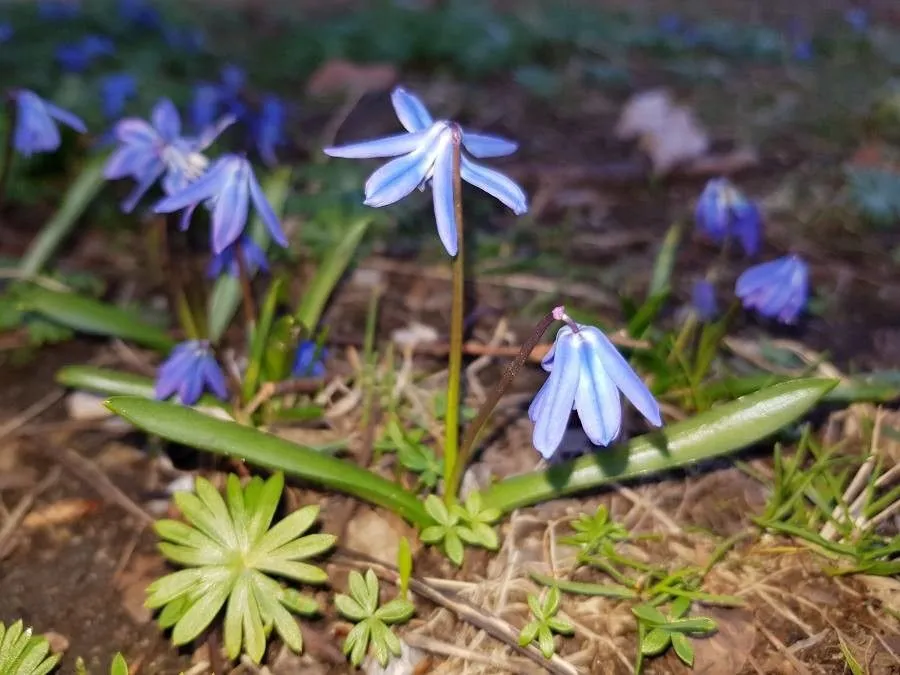
Author: Andrews
Bibliography: Bot. Repos. 6: t. 365 (1804)
Year: 1804
Status: accepted
Rank: species
Genus: Scilla
Vegetable: False
Observations: Krym to NW. Iran
Siberian squill, scientifically known as Scilla siberica, is a captivating flowering plant admired for its striking blue blossoms. This perennial herbaceous species belongs to the Asparagaceae family, which is well-regarded for its diverse and resilient plant members. The Siberian squill is native to a broad region stretching from the Crimea to northwestern Iran, thriving in these areas’ temperate climates.
First documented in the early 19th century, it was described in the prestigious Botanical Repository in 1804 by the botanist Andrews, marking its significance in botanical literature. The plant boasts a formidable adaptation to its native habitats and has become a favored choice among gardeners and horticulturists for its early spring blooms.
Typically, Siberian squill grows to a height of 10–20 centimeters, featuring slender, grass-like leaves and delicate, nodding flowers that are usually deep blue, although shades can slightly vary. These flowers bloom in clusters atop thin stems, creating an enchanting carpet of blue in naturalized settings like woodlands, gardens, and lawns.
One of the reasons for the popularity of Scilla siberica in cultivation is its ability to thrive in various soil types, although it prefers well-drained, moderately fertile soil. It is also relatively low-maintenance, requiring minimal care once established, making it an excellent choice for naturalizing bulb gardens. Its resilience to cold conditions ensures that it can withstand harsh winters, emerging each spring to herald the season’s arrival.
In addition to its ornamental value, Siberian squill plays a role in supporting local ecosystems. The flowers provide an early source of nectar for pollinators such as bees, which are crucial during the early spring months when other floral resources might be scarce. Consequently, planting Scilla siberica can enhance the biodiversity of garden spaces and surrounding areas.
Overall, Siberian squill stands out not just for its vibrant beauty and ease of growth but also for its historical botanical significance and ecological contributions. Whether used in formal garden settings, woodland landscapes, or naturalized lawns, Scilla siberica continues to captivate and charm plant enthusiasts worldwide.
Eng: siberian squill
En: Siberian squill, Wood squill, Squill
Ar: إشقيل سيبيري
Hy: Մկնասոխ սիբիրական
Az: Sibir zümrüdçiçəyi
Bg: Сибирски синчец
Cs: Ladoňka sibiřská
Da: Russisk Skilla
Nl: Oosterse sterhyacint
Et: Harilik siniliilia, Kahelehine siniliilia
Fi: Idänsinililja
Fr: Scille de Sibérie
Ka: Ციმბირული ცისთვალა
De: Nickende Sternhyazinth, Sibirische Sternhyazinthe, Sibirischer Blaustern, Nickende Sternhyazinthe
Hu: Bókoló csillagvirág
Is: Síberíulilja
Lt: Sibirinė scylė
No: Russeblåstjerne
Os: Æрдузы къах
Fa: نجمآبی گیلانی
Pl: Cebulica syberyjska
Ru: Пролеска сибирская
Sk: Scilovka sibírska
Sv: Rysk blåstjärna
Uk: Проліски пониклі
Cy: Seren Siberia
Taken May 24, 2019 by Gytha (cc-by-sa)
Taken Apr 23, 2013 by Andrzej Konstantynowicz (cc-by-sa)
Taken Apr 23, 2013 by Andrzej Konstantynowicz (cc-by-sa)
Taken Mar 31, 2014 by Andrzej Konstantynowicz (cc-by-sa)
Taken Apr 9, 2007 by Andrzej Konstantynowicz (cc-by-sa)
Taken Oct 9, 2015 by EOL − yaoshawn (cc-by-nc)
Taken Mar 19, 2020 by Kampf Robert (cc-by-sa)
Taken Feb 17, 2021 by Didier EYCHENNE (cc-by-sa)
Taken Apr 16, 2022 by Andrzej Konstantynowicz (cc-by-sa)
Taken Mar 5, 2020 by Katalea K (cc-by-sa)
Taken Jan 23, 2022 by christine Lesca Maillard (cc-by-sa)
Taken Apr 1, 2020 by Henk Van Lottum (cc-by-sa)
Taken Apr 21, 2020 by Christoph Häring (cc-by-sa)
Taken May 7, 2020 by Korčíková Eliška (cc-by-sa)
Taken Apr 23, 2018 by супернубик (cc-by-sa)
Taken Apr 11, 2022 by Petr Harant (cc-by-sa)
Taken Apr 11, 2022 by Petr Harant (cc-by-sa)
Taken Apr 13, 2022 by Elwer 23 (cc-by-sa)
© copyright of the Board of Trustees of the Royal Botanic Gardens, Kew.
© copyright of the Board of Trustees of the Royal Botanic Gardens, Kew.
© copyright of the Board of Trustees of the Royal Botanic Gardens, Kew.
Taken Apr 21, 2020 by Christoph Häring (cc-by-sa)
Growth habit>: Forb/herb
Ph maximum: 6.5
Ph minimum: 5.5
Light: 6
Atmospheric humidity: 6
Soil nutriments: 5
Family: Myrtaceae Author: (F.Muell.) K.D.Hill & L.A.S.Johnson Bibliography: Telopea 6: 402 (1995) Year: 1995 Status:…
Family: Rubiaceae Author: Pierre ex A.Froehner Bibliography: Notizbl. Bot. Gart. Berlin-Dahlem 1: 237 (1897) Year:…
Family: Sapindaceae Author: Koidz. Bibliography: J. Coll. Sci. Imp. Univ. Tokyo 32(1): 38 (1911) Year:…
Family: Asteraceae Author: A.Gray Bibliography: Pacif. Railr. Rep.: 107 (1857) Year: 1857 Status: accepted Rank:…
Family: Fabaceae Author: Medik. Bibliography: Vorles. Churpfälz. Phys.-Ökon. Ges. 2: 398 (1787) Year: 1787 Status:…
Family: Aspleniaceae Author: (Cav.) Alston Bibliography: Bull. Misc. Inform. Kew 1932: 309 (1932) Year: 1932…